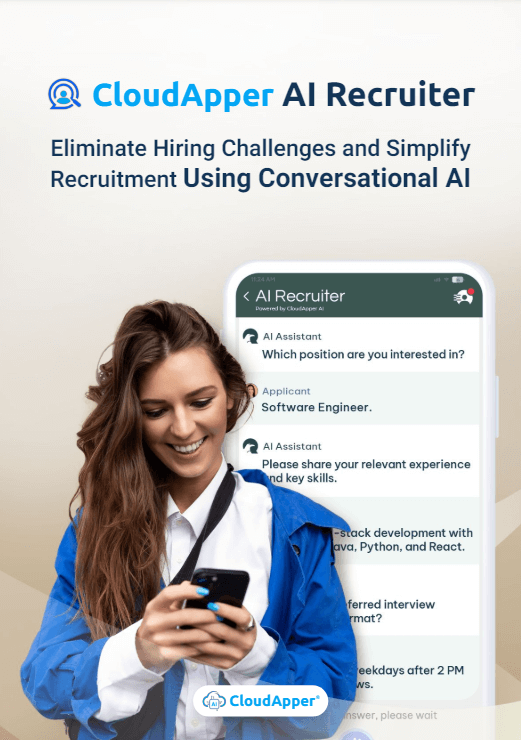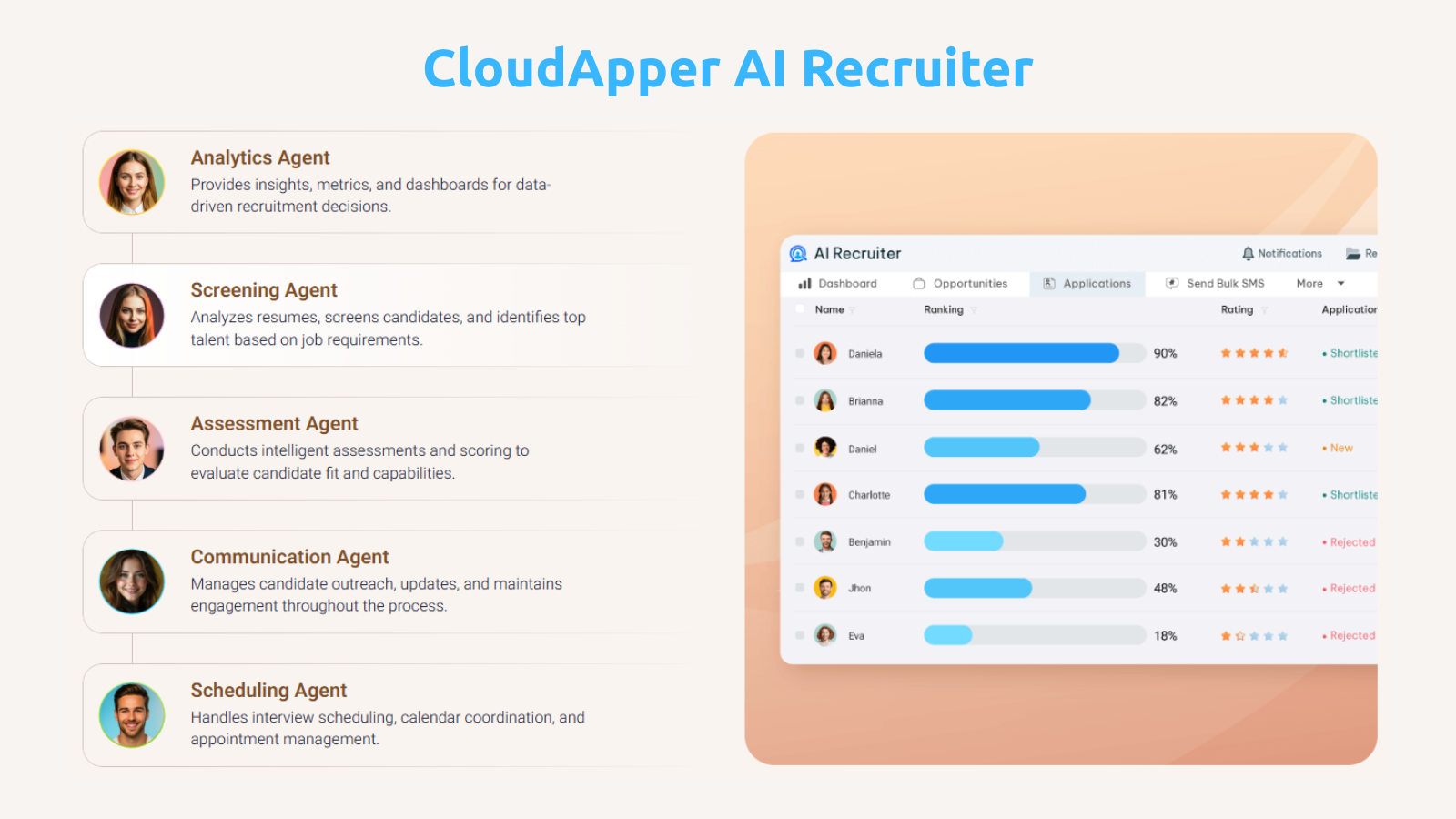A growing number of recruiters are turning to resume authenticity verification to separate real experience from AI-generated claims. This article explains why enterprises need a structured verification system and how CloudApper AI Recruiter uses contextual screening to help hiring teams validate skills, identify inconsistencies, and confidently move forward with genuine talent.
Table of Contents
In a hiring landscape where candidates are using AI to polish (and sometimes fabricate) experience, recruiters need more than instinct—they need a resume authenticity verification approach that scales. You’ve probably experienced it yourself: a resume that looks flawless on paper but unravels the moment you ask a real-world question. And with the pace of hiring increasing every quarter, the margin for error is shrinking fast.

For more information on CloudApper AI Recruiter visit our page here.
This is where solutions like CloudApper AI Recruiter are stepping in to help teams separate real talent from inflated claims. Instead of relying on manual resume checks or generic screening calls, recruiters are turning toward structured automation that validates a candidate’s background, skills, and responses with far more accuracy than traditional approaches.
In this article, we’ll break down why enterprises need a modern resume authenticity verification system, how the process works, where teams waste the most time, and how new AI-driven workflows are helping HR leaders make hiring trustworthy again.
Why Authenticity Is Becoming a Priority in Recruiting
Recruiting used to be simpler. A resume came in, you skimmed it, checked for relevance, and moved to a phone screening. But now?
-
AI writing tools can craft “perfect” resumes in minutes
-
Candidates can use AI to generate experience they never had
-
Generic interview prep bots can train applicants to give flawless—but memorized—answers
-
Fake skill claims are becoming harder to detect at scale
This is why so many hiring teams say the same thing:
“Resumes all start looking the same.”
A resume authenticity verification system helps recruiters uncover:
-
Skill exaggeration
-
Education or certification discrepancies
-
AI-generated accomplishments
-
Copied job descriptions disguised as experience
-
Fabricated technical capabilities
-
Misaligned career timelines
The goal isn’t to eliminate AI usage—it’s to ensure real talent shines through while unqualified candidates don’t slip through the cracks.
Where Traditional Screening Falls Short
Even the best recruiters admit that traditional screening methods have limits.
1. Resume reviews are subjective
Two recruiters can look at the same resume and form very different opinions. Human intuition is valuable, but inconsistency slows hiring and increases risk.
2. Time-consuming manual checks
Authenticating every detail—employment history, projects, certifications—takes hours. Multiply that by hundreds of applicants, and it’s clear why teams struggle.
3. Pre-screening calls reveal only so much
Candidates can rehearse perfect answers. Many sound great for 10 minutes but cannot demonstrate real knowledge once hired.
4. Reference checks are unreliable
Most references only confirm basic employment details. Very few provide detailed performance reviews unless there’s already a trusted relationship.
Because of these gaps, enterprises are adopting more structured resume authenticity verification methods to avoid expensive mis-hires and ensure fairness during screening.
What an Enterprise-Grade Resume Authenticity Verification System Looks Like
An effective system goes far beyond checking keywords or scanning for red flags. It must validate three layers:
Layer 1 – Resume Structure & Context Validation
This step helps verify whether the resume itself is logically consistent.
A robust system checks for:
-
Overlapping date ranges
-
Unrealistic career progression
-
Missing or vague responsibilities
-
Duplicate job descriptions copied from the internet
-
Job titles inconsistent with experience level
-
Undefined skill claims
Recruiters often spot these manually, but automation makes the process faster and more consistent.
Layer 2 – Experience & Skill Verification
Here’s where a modern resume authenticity verification system becomes indispensable.
It evaluates claims such as:
-
“Managed a cross-functional team of 20”
-
“Increased sales by 40%”
-
“Built a machine-learning model used for forecasting”
A strong system flags statements that feel too generic, inflated, or misaligned with previous roles.
This is also where CloudApper AI Recruiter plays a significant role. Instead of accepting resumes at face value, it asks contextual, scenario-based questions based on the candidate’s own claims. If someone says they built a forecasting model, the system may ask:
“Walk me through the steps you used when selecting the model architecture. Why did you choose that method?”
Real experience leads to real answers. AI-generated or fabricated experience usually falls apart here.
Layer 3 – Behavioral & Problem-Solving Validation
This layer checks whether candidates think the way their resumes suggest they should.
A modern system evaluates:
-
Problem-solving style
-
Ability to reason through new scenarios
-
Communication patterns
-
Consistency across multiple responses
-
Behavioral alignment with the role
This helps recruiters determine skill depth—not just surface-level competence.
Why Enterprises Need This System Now More Than Ever
The push for authentic hiring isn’t just about avoiding fraudulent candidates—it’s about building high-performing teams and reducing turnover.
1. Mis-hires are expensive
A bad hire can cost three to four times a candidate’s annual salary, especially for mid-level and senior roles. Enterprise recruiting demands accuracy.
2. Candidate volume is rising fast
Recruiters today handle far more applications than they did five years ago. Recognizing real talent is harder.
3. AI-generated resumes blur the lines
A resume that “sounds” credible doesn’t mean the candidate actually has the experience.
4. Talent scarcity pushes recruiters to move faster
You can’t spend days verifying each profile manually.
5. Internal stakeholders expect data-backed hiring decisions
Modern HR is accountable to metrics—and authenticity is becoming one of them.
A structured resume authenticity verification process ensures teams hire stronger, more reliable talent while reducing the burden on recruiting teams.
How CloudApper AI Recruiter Supports Authentic Hiring
Although this article is not promotional, it’s worth acknowledging how CloudApper AI Recruiter fits into this emerging trend.
Recruiters use CloudApper’s system because it:
-
Automatically extracts claims from each resume
-
Generates personalized questions to verify those claims
-
Detects inconsistencies in answers
-
Flags generic or AI-pattern responses
-
Ranks candidates based on real skill, not resume buzzwords
-
Provides insights that help hiring managers evaluate authenticity
Instead of relying on guesswork, CloudApper builds a layer of verification into the hiring process—without slowing it down.
This keeps authenticity aligned with speed, which is crucial for enterprise hiring.
Signs a Candidate May Not Be Fully Authentic
Here are some cues a resume authenticity verification system typically catches:
1. Overly polished phrasing
If the resume reads like a textbook, it may have been heavily AI-written.
2. Accomplishments lacking measurable detail
Real contributions tend to have actual numbers, context, or outcomes.
3. Skills unrelated to previous roles
For example:
An entry-level marketer claiming experience in “enterprise revenue forecasting models.”
4. Identical job descriptions across different roles
Often a sign that sections were copy-pasted from online templates.
5. Inconsistent storytelling
If the resume narrative doesn’t match verbal responses, that’s a strong signal of embellishment.
A resume authenticity verification system identifies these patterns quickly, allowing recruiters to focus on the candidates who truly align with the role.
The Ethical Side: Balancing Fair Screening With Authenticity Checks
Enterprises must ensure that new verification layers don’t unintentionally create bias or discourage candidates who simply write well or use tools to improve grammar.
A strong system should:
-
Evaluate content, not writing style
-
Ask consistent, role-based validation questions
-
Avoid penalizing candidates for using AI as long as the skills are genuine
-
Support structured, equitable comparison across applicants
Authenticity checks should enhance fairness—not limit opportunity.
How to Implement a Resume Authenticity Verification Process in Your Enterprise
Here’s a practical roadmap HR teams often follow:
Step 1: Define what “authenticity” means for your org
Different teams value different things—projects, results, problem-solving ability, leadership, or technical depth.
Step 2: Identify the roles most vulnerable to inflated claims
Engineering, sales, data science, and marketing are the usual starting points.
Step 3: Add claim extraction to your screening workflow
Solutions like CloudApper automatically identify claims that need validation.
Step 4: Build a structured question bank
Use scenario-driven questions that reveal real experience.
Step 5: Introduce consistency scoring
This helps compare candidates based on how reliably they explain their work.
Step 6: Train hiring managers on pattern recognition
Human + AI validation together creates the strongest system.
Step 7: Keep the candidate experience smooth
Authenticity checks should feel conversational, not interrogative.
Future of Resume Authenticity Verification
The next wave will likely involve:
-
Real-time skill validation
-
AI-driven fraud detection indicators
-
Behavioral consistency analysis
-
Automated interview integrity checks
-
Continuous learning systems that adapt to emerging fraud patterns
AI isn’t replacing recruiters—it’s reinforcing their ability to make accurate hiring decisions with confidence.
Conclusion
As resumes become easier to generate and harder to trust, enterprises need structured ways to validate authenticity without slowing hiring down. A modern resume authenticity verification system blends automation, contextual questioning, and consistent evaluation to help recruiters uncover real talent fast.
With solutions like CloudApper AI Recruiter supporting this shift, HR teams can finally screen at scale while prioritizing honesty, skill depth, and genuine experience.
Explore CloudApper AI Recruiter
What is CloudApper AI Platform?
CloudApper AI is an advanced platform that enables organizations to integrate AI into their existing enterprise systems effortlessly, without the need for technical expertise, costly development, or upgrading the underlying infrastructure. By transforming legacy systems into AI-capable solutions, CloudApper allows companies to harness the power of Generative AI quickly and efficiently. This approach has been successfully implemented with leading systems like UKG, Workday, Oracle, Paradox, Amazon AWS Bedrock and can be applied across various industries, helping businesses enhance productivity, automate processes, and gain deeper insights without the usual complexities. With CloudApper AI, you can start experiencing the transformative benefits of AI today. Learn More

CloudApper AI Solutions for HR



- Works with
- and more.
Similar Posts

How Can AI Help Recruiters Verify if Someone’s Experience is…

How Candidate Fraud Prevention Impacts Diversity and Inclusion



















